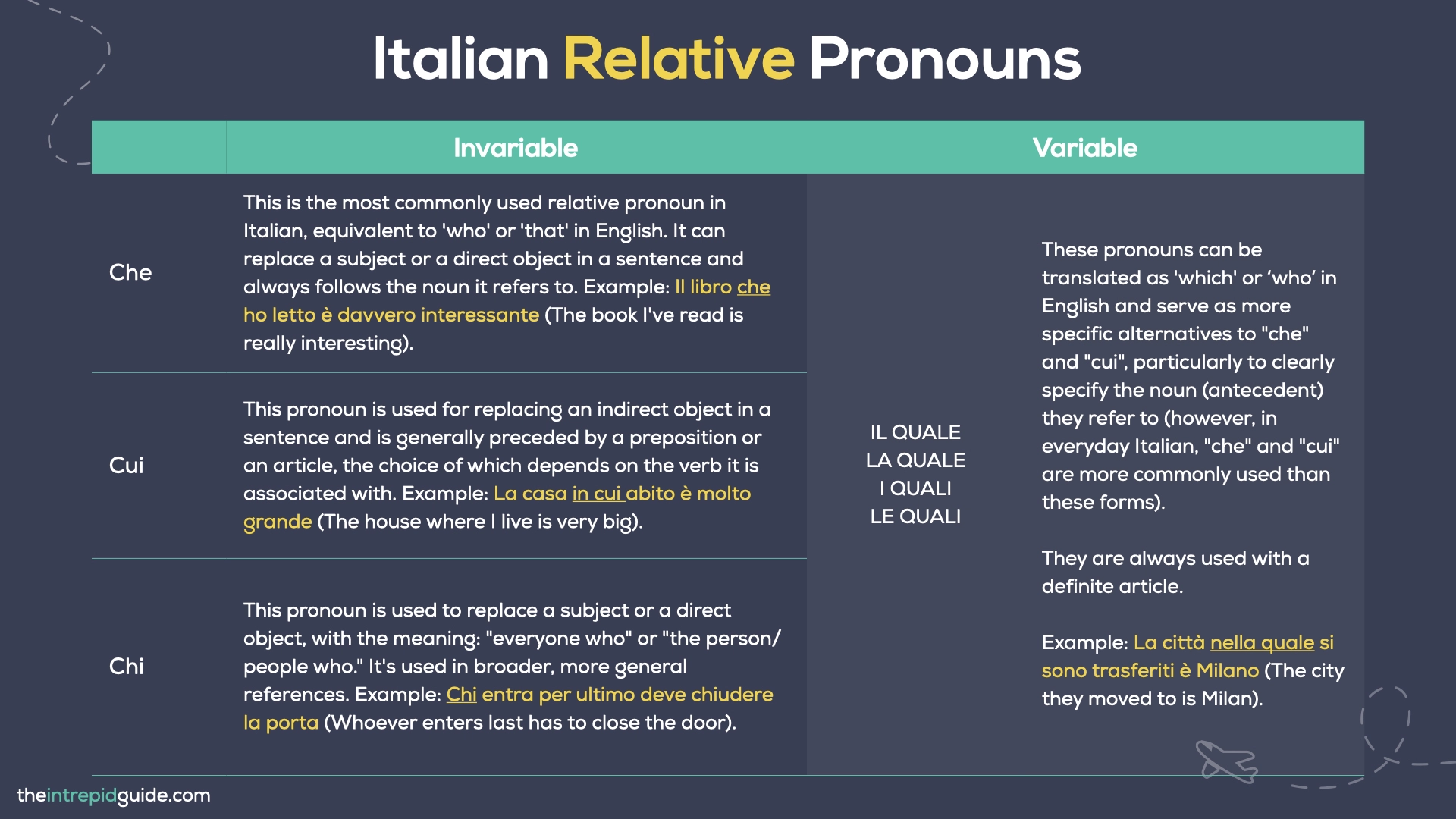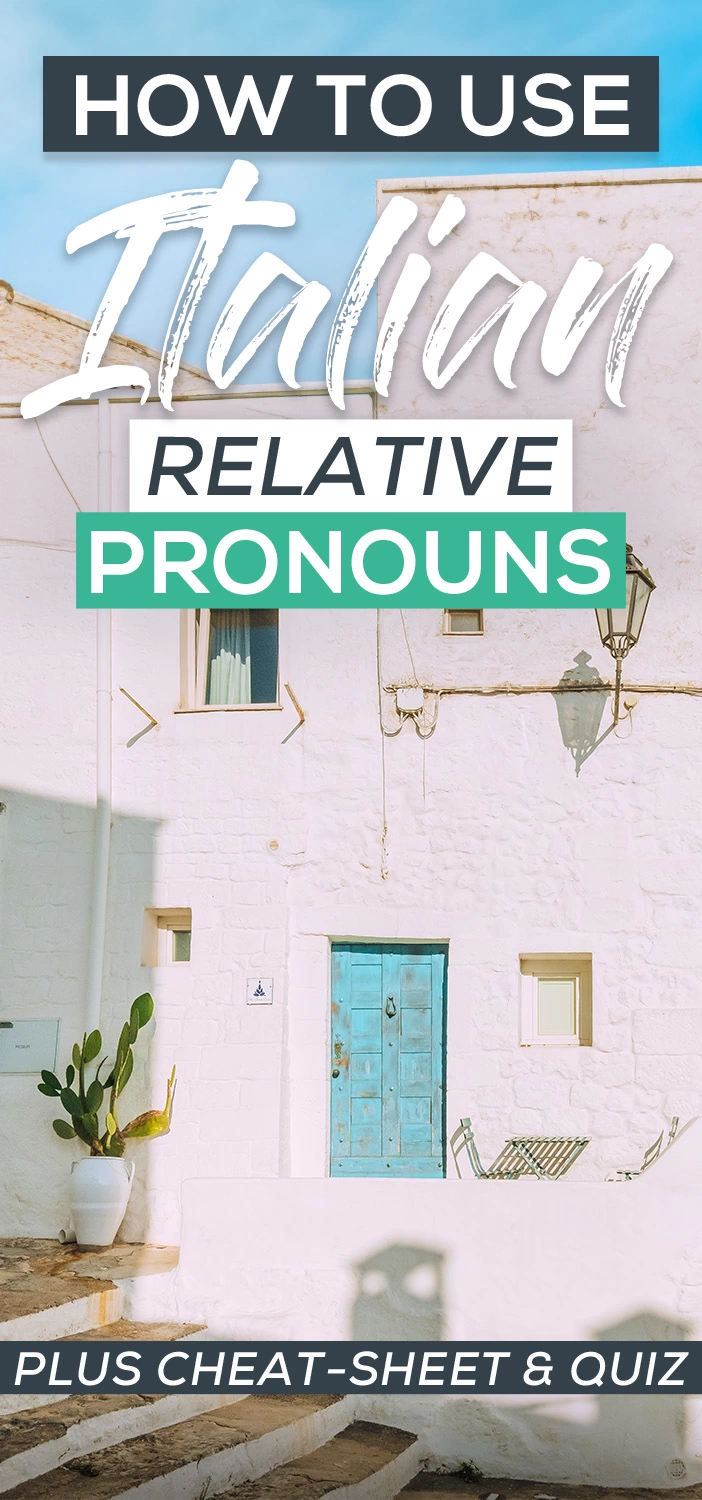Understanding Italian relative pronouns is key to connecting sentences smoothly. Suppose you’re staying in a hotel in Florence and the concierge recommends a restaurant. You might hear them say, Quando andate, chiedete del proprietario Salvatore, che è un mio amico (When you go, ask for the owner Salvatore, who is a friend of mine). Here, che is a relative pronoun, equivalent to “who” in English, and is used to link two pieces of information: Salvatore being the restaurant’s owner and the host’s friend.
Italian relative pronouns serve to connect sentences by referencing a noun from a preceding clause. They function similarly to English relative pronouns like “who,” “which,” or “that.”
Here’s another example:
- La ragazza è molto simpatica; ho conosciuto la ragazza al corso di nuoto. (The girl is very nice; I met the girl at swimming class.)
Here, la ragazza is the common element in both sentences. We can use a relative pronoun to combine these sentences, making the language more fluid and natural:
- La ragazza che ho conosciuto al corso di nuoto è molto simpatica. (The girl I met at swimming class is really nice.)
This guide will help you understand how relative pronouns in Italian integrate into various sentences, enhancing your fluency and comprehension. To see how much you’ve learned, don’t forget to complete the free quiz at the end of this lesson to test your new-found knowledge!
Before we get started, make sure you download your FREE PDF cheat-sheet for this lesson which includes a practical summary of everything you’ll learn in this guide. Just enter your email below and I’ll send it to you straight away.
By the way, want to improve your Italian quickly and having fun doing it?
I thought so.
If you’re a beginner, I recommend Intrepid Italian, my comprehensive self-paced programme that teaches you through the power of my unique 80/20 method. The course covers everything you need to know as a beginner in Italian (including how to use pronouns). Join now for lifetime access and my 30-Day “Celebrate with a Spritz” money-back guarantee by clicking here.
Or if you’re already at the intermediate level, why not enrol in Intrepid Italian for Advanced Beginners (A2) or Intrepid Italian for Intermediates (B1), my more advanced programmes that helps you master the trickiest aspects of Italian grammar while as you edge closer to fluency in Italian.
When you start learning Italian, it’s pretty common to keep repeating the same basic phrases and words, but if you’re gunning for fluency, it’s time to shake things up a bit. The key? Familiarize yourself with Italian pronouns to inject rhythm into your sentences!
Cominciamo! (Let’s get started!)
Italian Relative Pronouns Chart
| Italian Relative Pronouns | |
|---|---|
| Invariable | Variable |
| che | il quale, la quale, i quali, le quali |
| chi | |
| cui | |
How to use Italian Relative Pronouns
Che – The versatile pronoun
Usage: it replaces subjects or direct objects in a sentence, equivalent to ‘who’ or ‘that’ in English.
Characteristics: invariable in gender and number.
Here are some examples:
- Stai guardando la ragazza; la ragazza è mia sorella. (You’re looking at the girl; the girl is my sister.) —> La ragazza che stai guardando è mia sorella. (The girl you are looking at is my sister.), with che replacing la ragazza.
- La famiglia Rossi è molto simpatica; la famiglia Rossi abita al piano di sopra. (The Rossi family is very nice; the Rossi family lives upstairs.) —> La famiglia Rossi, che abita al piano di sopra, è molto simpatica. (The Rossi family, who live upstairs, is very nice.), with che referring to la famiglia Rossi.
- Stasera esco con un nuovo ragazzo; ho conosciuto il ragazzo al lavoro. (Tonight, I’m going out with a new guy; I met the guy at work.) —> Stasera esco con un nuovo ragazzo che ho conosciuto al lavoro. (Tonight, I’m going out with a new guy I met at work.), with che replacing il ragazzo.
Cui – For indirect objects
Usage: it replaces an Italian indirect object.
Characteristics: invariable in gender and number, it’s always preceded by a preposition, the choice of which depends on the verb it is associated with.
Here are some examples:
- Quel ristorante è eccellente; ieri sera abbiamo cenato in quel ristorante. (That restaurant is excellent; yesterday we had dinner in that restaurant.) —> Quel ristorante in cui abbiamo cenato ieri sera è eccellente. (The restaurant where we dined last night is excellent.), with in cui replacing in quel ristorante.
- Il libro è molto interessante; mi hai parlato del libro. (The book is really interesting; you told me about the book.) —> Il libro di cui mi hai parlato è molto interessante. (The book you told me about is really interesting.), with di cui replacing del libro.
- Il paesino è a soli 15 minuti da Firenze; Anna e Fabio provengono da quel paesino. (The village is just 15 minutes away from Florence; Anna and Fabio come from that village.) —> Il paesino da cui Anna e Fabio provengono è a soli 15 minuti da Firenze. (The village Anna and Fabio come from is only 15 minutes away from Florence.), with da cui replacing da quel paesino.
Attenzione!: the preposition is optional when cui serves as a complement of term, for example: La ragazza (a) cui ho dato il numero è bellissima (The girl to whom I gave the number is beautiful).
Chi – The people’s pronoun
Usage: replaces a person as a subject or direct object, with the meaning “everyone who” or “the person/people who”
Characteristics: invariable in gender and number
Here are some examples:
- Chi non dorme, non piglia pesci. (The early bird gets the worm.) – Here, chi means “everyone who.”
- Non riesco a parlare con chi non ascolta. (I can’t talk to someone who doesn’t listen.) – Here, chi means “people who.”
- Non sopporto chi parla male degli altri alle spalle. (I can’t stand people who talk badly about others behind their backs.) – Here, chi means “people who.”
Il quale, la quale, i quali, le quali – For specificity:
Usage: more specific alternatives to che and cui, helpful in clarifying ambiguous sentences.
Characteristics: variable in gender and number
Here are some examples:
- Sono uscita con il fratello di Maria, che veniva sempre a giocare qui. (I went out with Maria’s brother, who always used to come here to play). This sentence sounds a bit ambiguous because it’s unclear who used to come here to play. Depending on the case, you could say: Sono uscita con il fratello di Maria, il quale veniva sempre a giocare qui (if it was him) or Sono uscita con il fratello di Maria, la quale veniva sempre a giocare qui (if it was her).
- Ho incontrato Antonio con sua figlia, la quale lavora in polizia. (I met Antonio with his daughter, who works in the police). Here, la quale clarifies that it’s the daughter who works in police.
- Ho fatto due chiacchiere con il cugino della mia collega, il quale vive a Catania. (I had a chat with my colleague’s cousin, who lives in Catania). Here, il quale clarifies that it’s the cousin who lives in Catania.
Attenzione!: che and cui are more commonly used in everyday Italian. However, il quale and its variants are mandatory with the infinitive, gerund, and participle tenses:
- Infinitive: Mia figlia desidera un vestito di Valentino, per comprare il quale dovrà risparmiare per diversi mesi. (My daughter wants a Valentino dress, for which she will have to save for several months).
- Participle: Ho ancora un volo, terminato il quale sarò giunto a destinazione. (I still have a flight, after which I will have reached my destination).
- Gerund: Troverai alte colline, oltrepassando le quali si apre una vallata mozzafiato. (You will find high hills, beyond which a breathtaking valley opens up.)
Italian Relative Pronouns Quiz
Let’s test your knowledge of Italian relative pronouns. Fill in the blanks in these sentences using the correct relative pronoun.
If you found this lesson powerful, then you’ll love Intrepid Italian, my series of online self-paced video courses that break down everything you need to know about Italian using my 80/20 method. Visit IntrepidItalian.com for more details.
 Are you a beginner or an intermediate Italian learner? Got a trip coming up or want to communicate with your Italian partner or relatives in Italian? Learn Italian with my unique 80/20 method
Are you a beginner or an intermediate Italian learner? Got a trip coming up or want to communicate with your Italian partner or relatives in Italian? Learn Italian with my unique 80/20 method
Registrations are now open to join Intrepid Italian, my new series of online video courses that use my unique 80/20 method. You’ll go from a shy, confused beginner to a proficient and confident intermediate speaker, with me as your trusty guide.
You’ll finally be able to connect with your Italian partner, speak to your relatives and enjoy authentic travel experiences in Italy that you’ve always dreamed of, and so much more.
As a native English speaker who learned Italian as an adult, I know what it’s like to feel hopeless and lack the confidence to speak. I know what it’s like to start from scratch and to even go back to absolute basics and learn what a verb is!
Intrepid Italian was created with YOU in mind. I use my working knowledge of the English language to help you get into the ‘Italian mindset’ so you can avoid the common pitfalls and errors English speakers make – because I made them once too! I break everything down in such a way that it ‘clicks’ and just makes sense.
No matter what your level is, there is an Intrepid Italian course for you, including:
- 🇮🇹 Intrepid Italian for Beginners (A1)
- 🇮🇹 Intrepid Italian for Advanced Beginners (A2)
- 🇮🇹 Intrepid Italian for Intermediates (B1)
You can join 1, 2, or all 3 courses, it’s entirely up to you. The best part is that you have lifetime access so you learn anytime, anywhere and on any device.
As your guide, I walk you through each lesson, step-by-step, using my unique 80/20 method. My approach is different from traditional methods because I teach you the most important 20% of the language right from the beginning so you can start to speak straight away.
Each course includes video lessons, audio exercises, downloadable worksheets, bonus guides, a private support community, and lifetime access all designed to streamline your learning while having fun.
It even comes with my famous “Celebrate with a Spritz Guarantee”. After 30 days of using Intrepid Italian, if you don’t want to celebrate your new-found Italian skills with an Aperol Spritz, you don’t have to pay a penny! Cheers! 🥂
Join Intrepid Italian here and start learning today!
Ci vediamo lì! (See you there!)
Learning Italian? Check out these Italian language guides
- Italian for Beginners | How to Learn Italian in 3 Simple Steps
- TOP 100 Most Common Italian Words (Plus PDF Cheat-Sheet & Quiz)
- Italian Prepositions:The Only Guide You’ll Ever Need (PLUS Chart)
- 17 Weird Italian Superstitions Italians ACTUALLY Live By
- 17 Must-Know Italian Hand Gestures: The Ultimate Guide
- 10 Ways Natives REALLY Say ‘You’re Welcome’ in Italian
- How to say ‘Please’ in Italian in 9 Ways Like a Native
- 41 Italian Greetings: How to Say ‘Hello’ in Italian Like a Local
- 125 Most Common Italian Phrases for Travel You’ll Ever Need [PLUS Printable]
- 8 DEADLY mistakes in Italian (& How to Avoid Them)
- How to Conjugate Italian Verbs in 3 Simple Steps [Italian for Beginners]
- Is Italian Hard to Learn? 7 Common Mistakes & How to Avoid Them
- Master Days of the Week in Italian (7 Simple Memory Hacks)
- Italian Numbers: How to Count in Italian From 0 to 1 Billion (Plus PDF Download)
- How to Order Food & Drinks in Italian [Italian for Beginners]
- 15 Italian Words You Should NEVER Mispronounce [& How Not To]
- 11 Effective Hacks That’ll Help You Learn Italian So Much Faster
- Top 14 Italian Words You Should NEVER Say [& What to Use Instead]
- 20 Hilarious Everyday Italian Expressions You Should Use
- Romanesco: 25 Cool Roman Dialect Words You Should Use in Rome
- 10 Reasons Why Learning Italian Will Change Your Life
- 10 Italian Expressions Italians Love Saying
- 10 Italian Phrases That Will Instantly Make You Sound more Italian
- Funny Italian Sayings: 26 Food-Related Insults You Won’t Forget
- 15 Romantic Italian Films That’ll Make You Love Italy Even More
- How to Master Common Italian Phrases for Travel (Like a Local!)
Like it? Pin it for later!
Over to you!
Did you enjoy this lesson? Do you have a question? Let me know using the comments section below or join me on social media @intrepidguide or @intrepiditalian to start a conversation.
Thanks for reading and I hope you enjoyed this post.
Like what you see? Subscribe using the form below to have all of my posts delivered directly to your email.




